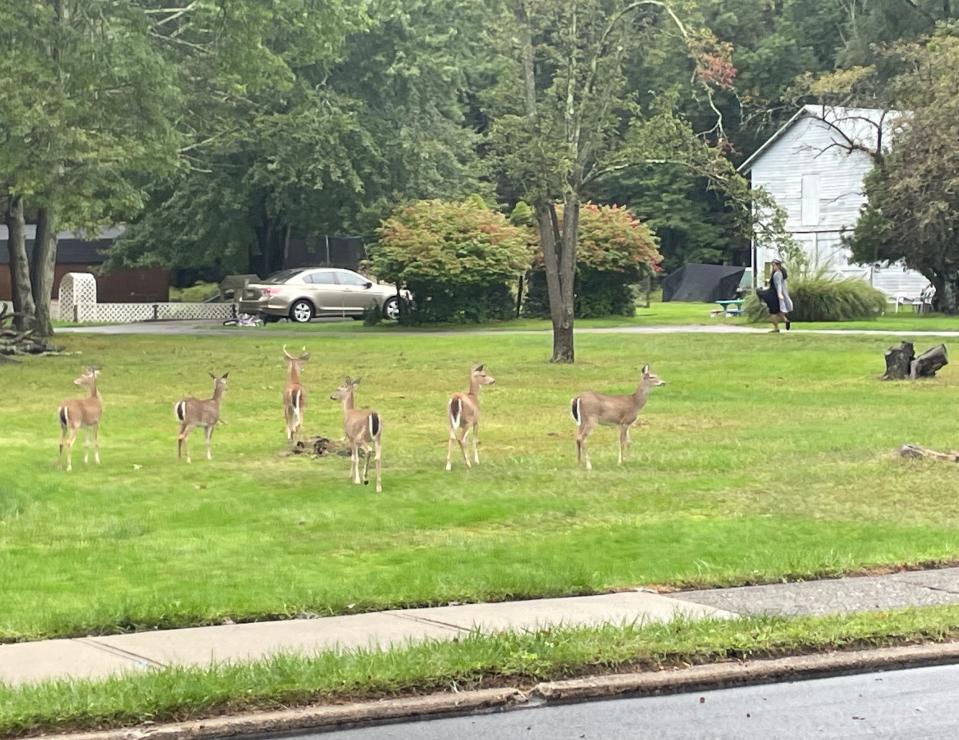Noticing more deer along the side of the road in NJ recently? Here's why
Many New Jersey residents are fond of their neighbors, including the white-tailed deer that inhabit the area.
Unfortunately, they are also used to seeing numerous deer lying on the side of the road during their daily commute.
While deer are always something to watch out for while driving around New Jersey, there are certain times each year when it seems there are a lot more deer on the side of the road, and when drivers should be on higher alert for deer crossings.
When are deer most active?
October through December is peak deer time around the state, as it is the deer rutting season, also known as mating season. During this time, bucks are competing for does, leading to more aggressive and irrational behavior. With a buck in pursuit of a doe, both are more likely to dart across the road in front of oncoming drivers, said an Oct. 12 press release from the New Jersey Department of Environmental Protection.
Another reason for increased deer activity is the time change, which occurred on Nov. 5.
“The deer move the most at dawn and at dusk. Right now, with the time change, they are naturally moving at 5 o’clock at night when it is getting dark, which is the same time that most commuters are on the road. During the summertime, they might not start moving until 8:30 or 9 o’clock at night, when most people are already home from work,” said Parker Space, a state assemblyman and owner of Space Farms Zoo and Museum.

Space works with North Jersey counties to clear dead deer from the side of the road. He works with Sussex, Warren, Union and Morris counties to remove the deer from county and municipal roads, feeding usable parts of the deer to his animals at the zoo and sending the remaining parts to the landfill.
According to Space, the crews pick up anywhere from 10 to 25 deer a day between October and the end of November. That number doesn’t include deer picked up from state roads, because those are handled by state-run organizations.
How to avoid deer while driving
Although it can be stressful weaving through the thousands of deer that live around the state, there are things that New Jersey drivers can do to be prepared and avoid collisions with deer.
“The biggest thing is, if you see a deer come out into the road and it runs across, there is a really good chance there’s going to be another deer right behind it,” said Space. “I think that causes a lot of the accidents. A deer will run across in front of somebody and they’ll just keep on going at 50 or 60 miles an hour and there’s usually going to be more deer coming.”
Space also said to keep an eye out for deer crossing signs.
“Usually, they cross at the same areas," he said. "If you see a deer at one spot and then a couple of days later you see another one, keep that spot in mind. They have territorial paths that they tend to stay on.”
The DEP shares some additional advice for motorists, including slowing down when you come across a deer, using your high beams when it is safe to do so while driving at night, avoiding tailgating in case the driver in front of you stops suddenly for a deer, and staying off handheld devices while driving.
Additionally, try not to swerve if you see a deer coming, as that could lead to a worse accident. Instead, brake as much as you can safely and try to stay in your lane to avoid colliding with another car.
“Deer are involved in thousands of collisions with motor vehicles in New Jersey each year, with the highest number occurring during the fall mating season,” DEP Fish and Wildlife Assistant Commissioner Dave Golden said in a release. “It is very important that motorists in all parts of the state be alert to the possibility of deer suddenly darting onto roadways, and to follow some basic guidelines to stay safe.”
This article originally appeared on NorthJersey.com: Deer in NJ more active during fall, and road collisions rise

